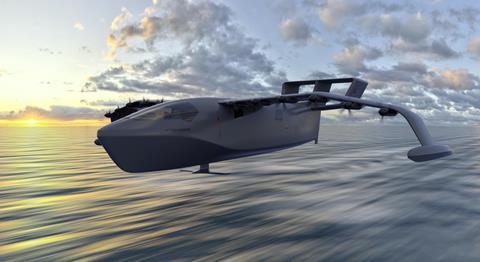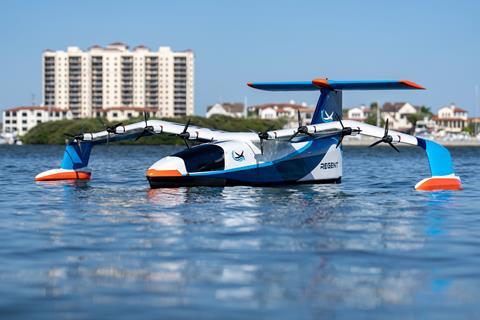The US military is exploring the potential of an experimental amphibian wing-in-ground-effect vehicle to improve logistics in maritime environments.
The US Marine Corps (USMC) is contracting with Rhode Island-based start-up Regent to demonstrate the company’s “seaglider” concept, which combines elements of hydrofoil ships with wing-in-ground-effect aircraft to move rapidly over water at low altitude.
Regent announced the $4.75 million deal with the USMC on 18 October.

“Rapidly fielding technology that addresses the growing need for island hopping capabilities in the Indo-Pacific is paramount for Regent,” says co-founder and chief executive Billy Thalheimer.
Regent’s craft, which it calls “seagliders”, operate exclusively in maritime domain. The all-electric craft take off and land from the water with a hull and hydrofoils, before transitioning into ground effect flight just a few metres above the surface.
At such altitudes, vessels can benefit from the efficiency-improving phenomenon known as ground effect that occurs when a cushion of air forms between a craft’s wings and the surface. In the civil realm, the hybrid form of travel has raised questions about how these vehicles and other ground effect craft will be regulated and certificated.
Regent argues the seaglider concept offers the lower maintenance requirements of a ship, plus the speed of an aircraft, but without the lengthy pilot training and air defence vulnerability of helicopters and conventional aircraft.
The goals of the USMC demonstration programme are to validate the craft’s ability to operate in each of its hull, foil, and wing-borne modes of operation, Regent says. The trials will inform craft-level certification requirements and offer the Pentagon an opportunity to evaluate the vehicle’s potential in military operations.
Regent says the programme will culminate with a live exercise involving a full-scale seaglider prototype.
Until recently, Regent was focused exclusively on developing the vehicle as a commercial vehicle. The company has secured provisional and firm orders with potential value of $8 billion from ferry operators and airlines.

The push into the defence realm began in 2022, when the US military began seriously exploring how seaplanes or other maritime craft could improve operations in the Indo-Pacific theatre – a space defined by vast open ocean distances and small islands with minimal infrastructure.
“It’s really been a result of seeing where the national defence strategy is moving, in terms of a focus on the Pacific, on island chains, on littoral combat, on high-speed logistics and contested logistics in these littoral and archipelagic environments,” Thalheimer told FlightGlobal in an April interview.
“Our vehicles are perfectly suited for that mission,” he adds.
The USMC apparently agrees, at least enough to fund a demonstration.
While the service already has the capability to transport personnel and cargo long distances using its Sikorsky CH-53K heavy-lift helicopters and Bell Boeing V-22 Osprey tilt-rotors, those aircraft are vulnerable to air-defence missiles and limited by physical constraints, including availability of suitable landing zones and of jet fuel.
“It’s a recognised capability gap by the Marine Corps”, Thalheimer says. One, he argues, that Regent’s seagliders are well-suited to fill. “It gives you aircraft speeds, with the flexibility, runway independence and ease of loading and offloading a vessel.”
Regent says seagliders will be able to cruise at 156kt (290km/h) and have 156nm (290km) of range on a single charge. The craft boasts a capacity of 12 passengers or 1,587kg (3,500lb) of cargo.


























